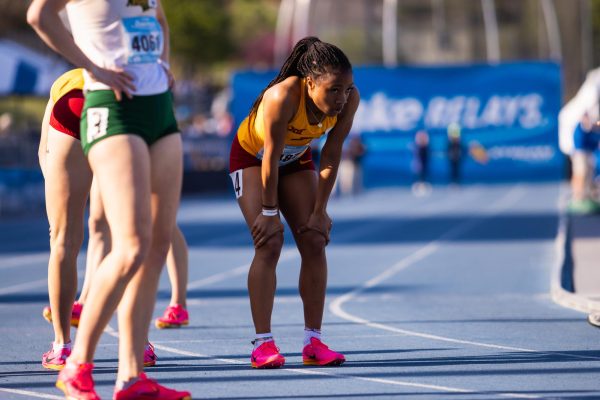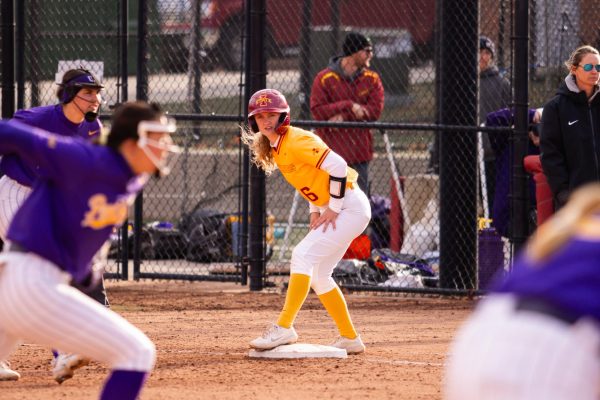The ways of the dragon
December 9, 2003
Saturday morning sees activity throughout Beyer Hall. In fact, it’s probably as busy as any time during the work week.
People and their stuff are spilling into the hallways while they use the ISU facilities to practice their chosen game — swimming, gymnastics, volleyball, racquetball.
For the fifth time this week, Dragon Arts, an ISU organization, is also using Beyer. But the group has claimed a pair of squash courts for an activity different from the others.
In one court, four students practice various forms of kung fu, testing for advancement to different levels of achievement of the traditional Chinese martial arts. Six others are testing in the neighboring court.
These four are watched by Cornell Garrett, president of Dragon Arts’ parent facility in Omaha, Neb., who observes as the black-clad warriors move about the court performing arm, leg and body motions smoothly and sometimes suddenly.
Eventually, Garrett gathers his charges for a lengthy discussion.
“The more you know, the more you get out of it,” he tells them.
The school
The class participants said that’s the truth.
“I schedule work around it — it’s that important,” said Greg Utterback, junior in biology. “It teaches you discipline.”
The ISU classes are taught by Jimmy Betts, sophomore in computer engineering. Betts learned his craft at Garrett’s larger school in Omaha, which teaches the various aspects of Mountain Way, a course of study in traditional Chinese life arts. That practice includes courses that take students along the “paths” of warrior, healer, scholar and sage — more breadth than a Hollywood-fed public might assume about martial arts.
“The system is so diverse,” Betts said. “If you do it, you’ll find something.”
Garrett, who visits Ames about once a month to conduct testing and teach more “academic” courses (Betts can teach the daily courses but isn’t allowed to test until he achieves black sash), said the Dragon Arts system provides different programs to match with different people and personalities.
“We consider Dragon Arts a ‘life arts’ center,” he said. That term refers to the study of a person’s own life — in this case, through the four paths of study Dragon Arts uses.
Creating an Ames affiliate
After starting with a smaller group last year, Dragon Arts has both beginner and advanced classes to serve first- and second-year students, Betts said. He added that he is already beginning to structure ways for the program to continue after he graduates.
“[Teaching] is a good way to keep me sharp,” he said.
Betts said he is making steady progress in his own studies, through practicing on his own and from Garrett’s instruction. Garrett said he is proud of Betts’ accomplishments in starting the school nearly from scratch.
“I knew that Jimmy was an exceptional student,” he said. “[Teaching] would pressure him to keep his training.”
The Omaha school operates mainly out of a 3,600 square-foot facility.
Garrett said he hoped the ISU version would continue to grow and involve more of the Ames community.
“We’re already working on putting those plans in motion,” he said.
Steady growth
The nightly classes concentrate on building students’ basic techniques, physical and mental endurance and more complex skills.
Betts started the ISU affiliate when he came to Ames in the fall of 2002, and the size of classes has grown since.
“When I came to college, I always wanted to take a martial arts class,” said Stephanie Tang, junior in marketing. “It’s the way I have to relieve stress.”
Tang said she liked the way the kung fu classes balanced the development of physical prowess with a concern for mental and physical health and the concept of a life art.
“Self-defense is a good reason, but it shouldn’t be the sole reason [to take a particular class],” she said.
Tang added that she didn’t think “showing off should be the goal of a martial arts practice.”
“That just corrupts the whole philosophy and beauty of it,” she said.
Varied curriculum
Individual sessions of classes Wednesday and Thursday follow roughly the same pattern, but within that pattern are several widely contrasted routines and drills.
After stretching, Betts observes as students practice quick striking techniques — each maneuver in both right- and left-handed (or footed) varieties — during which the squash court echoes with terse commands, determined vocal responses and the rumbling of backpedaling feet.
Betts occasionally halts the class to correct a technique, or to demonstrate it himself.
Later, students do various “power training” drills — trying to hold still in a near-seated position, called the “horse stance,” or standing on hands or other challenging methods. Here, the sound nearly vanishes — it’s only breathing.
The last portion of each class deals with applying the single moves and endurance learned earlier into a complete package.
Joining the school
Betts said he and his senior students work privately with prospective students to assess their interests before they begin classes with the larger group.
“Not everyone is interested in martial arts for the same reasons,” Betts said. “We try to get a feel of what [people] are looking for.”
“Confidence is a big [benefit],” said Nate Hering, junior in mechanical engineering. “It’s something to bring your focus in.”
Chuck Packard, freshman in materials engineering, is in his first semester as a Dragon Arts student. He said he plans to stick with it — partly because of what Garrett once told the students when he visited.
“[He said], ‘You haven’t even gotten to the tip of the iceberg until you’ve gotten your black sash,'” Packard said.
















